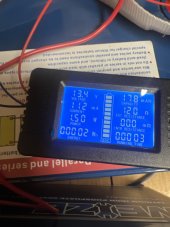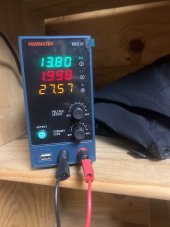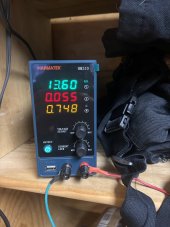You are using an out of date browser. It may not display this or other websites correctly.
You should upgrade or use an alternative browser.
You should upgrade or use an alternative browser.
How to determine if Lifepo batteries are bad
- Thread starter Sonnyboy
- Start date
sunshine_eggo
Happy Breffast!
No but I can put it on there. From what while we said, I thought using the DMM would be more accurate. I’ll hook it up.
EDIT: nevermind.
So far this seem ok. I might not leave it unattended overnight in case something unexpected happens, but as long as you did not adjust the voltage on the power supply after connecting it should be fine. It is normal for it to take a very long time if the battery is not nearly full alreadyUpdate: first battery charged to 13.8 in just over 24 hrs. Second has been charging but stuck here(picture) or near here for most of the day. Will leave it overnight and see tomorrow. This was the battery that I had mistakenly connected pos to neg when hooking up two in parallel. Hope I didn’t fry it. The DMM reads 13.6
Watch the current. If current suddenly goes to 0.00 then the BMS has cut off charging. Let's assume that won't happen, but write back here if it does.
You will want to repeat this, first to get the batteries to 14.0v, and then again to get them to 14.2v. Both of those steps should go pretty quickly.
Also, the wires that come with power supplies are crappy. It will go much faster if you make new wires that you ring terminals you can bolt to the battery and PS instead of banana plugs and alligator clips.
sunshine_eggo
Happy Breffast!
Update: first battery charged to 13.8 in just over 24 hrs. Second has been charging but stuck here(picture) or near here for most of the day. Will leave it overnight and see tomorrow. This was the battery that I had mistakenly connected pos to neg when hooking up two in parallel. Hope I didn’t fry it. The DMM reads 13.6
Bump to 14.4V and continue charging. note how much is input after current drops to 0
sunshine_eggo
Happy Breffast!
So far it looks like your prior charger just wasn't up to the task of charging these batteries.
What is the total amount of Ah you've input into battery #2?
What is the total amount of Ah you've input into battery #2?
I’m not sure. Do you mean how long did I charge it for? This morning it was charged to 14.4. When I read after disconnecting, it dropped to 14.2So far it looks like your prior charger just wasn't up to the task of charging these batteries.
What is the total amount of Ah you've input into battery #2?
sunshine_eggo
Happy Breffast!
I’m not sure. Do you mean how long did I charge it for? This morning it was charged to 14.4. When I read after disconnecting, it dropped to 14.2
No. That was the purpose of the battery monitor - see how much you put into the battery.
Right. Figured that out after I disconnect the meter. Oops. Now reads 14.1 on DMMNo. That was the purpose of the battery monitor - see how much you put into the battery.
Consumerbot3418
Fitting square pegs into round holes... for fun?
Right. Figured that out after I disconnect the meter. Oops. Now reads 14.1 on DMM
No worries--It'll still be useful for measuring the capacity of your batteries as you discharge them. Although it certainly would've been interesting to have known how much energy you were able to dump in.
I was using a Battleborn 100ah in my 5th wheel a few years ago, and never really could get it to charge well off the built-in WFCO "converter". If I put a good load on it, it'd drop the voltage down enough that the WFCO would put out max current for a while. But lead acid battery chargers don't want to destroy the battery by over-charging, and that means the the so-called "drop-in" LiFePos just don't get fully charged, and over time, become unbalanced. In my case, I had a Victron MPPT charging it according to the recommended settings, on sunny days at least.
With any luck, your issue is/was just unbalanced cells. Hoping to hear good news once you've completed the discharge test!
Thanks, me too! Can you you explain to me like I’m a two year old, how to do a discharge test? I read the earlier post three times but can’t follow it.No worries--It'll still be useful for measuring the capacity of your batteries as you discharge them. Although it certainly would've been interesting to have known how much energy you were able to dump in.
I was using a Battleborn 100ah in my 5th wheel a few years ago, and never really could get it to charge well off the built-in WFCO "converter". If I put a good load on it, it'd drop the voltage down enough that the WFCO would put out max current for a while. But lead acid battery chargers don't want to destroy the battery by over-charging, and that means the the so-called "drop-in" LiFePos just don't get fully charged, and over time, become unbalanced. In my case, I had a Victron MPPT charging it according to the recommended settings, on sunny days at least.
With any luck, your issue is/was just unbalanced cells. Hoping to hear good news once you've completed the discharge test!
Consumerbot3418
Fitting square pegs into round holes... for fun?
Sure, should be dead simple, now that you have a shunt/meter!
If you apply a large load (up to the rated current, which I believe is 100 amps, circa 1200 watts, in your case), the test will go faster: it should take around an hour at that rate. If you apply a smaller load, like 120 watts, it should take around 10 hours. Smaller charge and discharge currents are more kind to the battery cells, and more efficient. So if you did the two tests I just described, you'd expect to see a higher energy count on the smaller load.
You could use any 12V/automotive device as a load, like a headlight bulb, for instance. I did my own capacity test on a similar spec battery recently, using a space heater plugged into an inverter, set to low, circa 800 watts. I ended the test when 100 minutes elapsed, and the energy counter was over 1300. I was satisfied with having all the capacity I paid for, and wanted to be kind to the battery. In retrospect, I probably should have let the BMS cut the test with low voltage disconnect, just to be sure that function works.
Good luck!
- Hook up the meter (make sure "energy counter" is reset to 0)
- Apply a load
- Wait for the BMS to cut off the output
- Look at the energy counter
If you apply a large load (up to the rated current, which I believe is 100 amps, circa 1200 watts, in your case), the test will go faster: it should take around an hour at that rate. If you apply a smaller load, like 120 watts, it should take around 10 hours. Smaller charge and discharge currents are more kind to the battery cells, and more efficient. So if you did the two tests I just described, you'd expect to see a higher energy count on the smaller load.
You could use any 12V/automotive device as a load, like a headlight bulb, for instance. I did my own capacity test on a similar spec battery recently, using a space heater plugged into an inverter, set to low, circa 800 watts. I ended the test when 100 minutes elapsed, and the energy counter was over 1300. I was satisfied with having all the capacity I paid for, and wanted to be kind to the battery. In retrospect, I probably should have let the BMS cut the test with low voltage disconnect, just to be sure that function works.
Good luck!
Does the charger ever get to zero? I’ve seen mine get to .017 current but not lower. This battery is at .054.Important note. DO NOT trust the voltage reading from the battery meter for charging purposes. It might be as much as 200mv off, which makes a difference. To measure BATTERY voltage, use a DMM directly on the battery. To measure charger voltage, use a DMM directly on the power supply. These readings will sometimes not be the same. And never adjust the power supply when it is connected. Disconnect, adjust, then reconnect.
Attachments
RCinFLA
Solar Wizard
- Joined
- Jun 21, 2020
- Messages
- 3,566
Typical leakage current is 1 to 2% of cell capacity per month at mid SoC. For a 280 AH cell that would be equivalent to about 4 AH leakage bleed per month or about 6 mA of continuous leakage current. For 100 AH cell, about 2 mA.
When cell is held above 3.45v charging voltage there will be additional overcharge current that will increase minimum absorb current the greater the absorb voltage is above 3.45v.
If there is also a BMS involved, like for a self-contained 12v LFP battery, there may be balancing bleed current and power to run the BMS. The BMS processor has run and standby modes so its current consumption is variable depending on its mode of operation. When it is detecting charging current it may not idle cycle the processor as often and does more frequent checking of cell voltage and current.
When cell is held above 3.45v charging voltage there will be additional overcharge current that will increase minimum absorb current the greater the absorb voltage is above 3.45v.
If there is also a BMS involved, like for a self-contained 12v LFP battery, there may be balancing bleed current and power to run the BMS. The BMS processor has run and standby modes so its current consumption is variable depending on its mode of operation. When it is detecting charging current it may not idle cycle the processor as often and does more frequent checking of cell voltage and current.
No, it will never reach zero. It will get close, then stop going down.Does the charger ever get to zero? I’ve seen mine get to .017 current but not lower. This battery is at .054.
Charging too long after this point can overcharge the battery, so when its close to zero and stops going down, consider it done.
I have two 4 amp batterytender with lithium settings … I used them back in 2020 to charge my 12v lithium batts while I bought other stuff to build a system..I had a voltmeter hooked to them while the charging occurred about every 3 month…I am suspect of any charger that has an LFP setting, but doesn't tell you or let you adjust what that is. Many cheaper chargers that claim compatibility with LFP will change to LFP voltages (14.4-14.7) but NOT change absorption times or tail-current, or float voltages. These chargers will charge LFP batteries, but over time will damage them and reduce their capacity.
I have not tested the Battery Tender to know one way or another. But they don't seem to publish this information, and conceptually, what the battery tender is (a battery maintainer) is a function that is needed for Lead-Acid, but damaging to LFP.
Further diagnostic requires a charger where you can specifically set the voltage, absorption time, and measure current.
the readings went all over the place …bizzare readings..
I finally got some Victron equipment and it all settled down to normal readings…
it’s all fine now…
I don’t think they are made for what batts I owned at that time…don’t know but somthing wasn’t right.
I do not understand how so many newbies come on here , cop an attitude and want to argue their case with pros who know 100x what they know….Using a multimeter, while witnessing the battery icon on the MT50 showing full battery and 13.8v, the multimeter also read the same, within .05 volts. Every so often, the MT50 would report a spike in battery voltage to 15-16v and then it would abruptly drop to 12.5 and stay there for a while before returning to somewhere between 13 and 13.8 volts.
if you know this stuff , then why are you here…?
if you don’t know , then why are you arguing..?
I am impressed at the patience some of the forum guys have…
I would be going to get in a car and go beat these guys up after to listening to their nonsence..
this is why I would never offer tech advice to anyone…about anything..even if I were smart ….
Similar threads
- Replies
- 21
- Views
- 773
- Replies
- 3
- Views
- 168
- Replies
- 6
- Views
- 273








